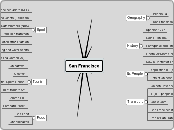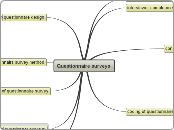Grade Eight
United States History and Geography: Growth and Conflict
Skills Attainment and Social Participation
Basic Study
CCSS>ELA Literacy WHST6-8.5 With some guidance and support from peers and adults develop and strengthen writing as needed by planning, revising, editing, rewriting, or trying a new approach, focusing on how well purpose and audience have been addressed.
CCSS.ELA-Literacy.RH.6-8.5 Describe how a text presents information (e.g., sequentially, comparatively, causally).
CCSS.ELA-Literacy.RH.6-8.4 Determine the meaning of words and phrases as they are used in a text, including vocabulary specific to domains related to history/social studies.
Critical Thinking
CCSS>ELA Literacy WHST6-8.4 Produce clear and coherent writing in which the development, organization,and style are appropriate to task, purpose and audience.
CCSS.ELA-Literacy.RH.6-8.9 Analyze the relationship between a primary and secondary source on the same topic
H-SS AS Students assess the credibility of primary and secondary sources and draw sound conclusions from them.
CCSS.ELA-Literacy.RH.6-8.2 Determine the central ideas or information of a primary or secondary source; provide an accurate summary of the source distinct from prior knowledge or opinions.
Participation
Subtopic
CCSS>ELA Literacy.WHST.6-8.9 Draw evidence from informational texts to support analysis, reflection, and research.
CCSS.ELA-Literacy.RH.6-8.8 Distinguish among fact, opinion,and reasoned judgment in a text.
H-SS AS Students distinguish fact from opinion in historical narratives and stories.
CCSS.ELA-Literacy.RH.6-8.6 Identify aspects of a text that reveal an author's point of view or purpose (e.g., loaded language, inclusion or avoidance of particular facts).
Democratic Understanding and Civic Values
Civic Values
8.3.7. Understand the functions and responsibilities of a free press.
8.3.5. Know the significance of domestic resistance movements and ways in which the central government responded to such movements (e.g., Shays’ Rebellion, the Whiskey Rebellion).
8.3.1. Analyze the principles and concepts codified in state constitutions between 1777 and 1781 that created the context out of which American political institutions and ideas developed.
Constitutional Heritage
8.2.5. Understand the significance of Jefferson’s Statute for Religious Freedom as a forerunner of the First Amendment and the origins, California Department of Education purpose, and differing views of the founding fathers on the issue of the separation of church and state.
8.2.3. Evaluate the major debates that occurred during the development of the Constitution and their ultimateresolutions in such areas as shared power among institutions, divided state-federal power, slavery, the rights of individuals and states (later addressed by the addition of the Bill of Rights), and the status of American Indian nations under the commerce clause.
8.2.2. Analyze the Articles of Confederation and the Constitution and the success of each in implementing the ideals of the Declaration of Independence.
National Identity
8.9.6. Describe the lives of free blacks and the laws that limited their freedom and economic opportunities.
8.6.3. List the reasons for the wave of immigration from Northern Europe to the United States and describe the growth in the number, size, and spatial arrangements of cities (e.g., Irish immigrants and the Great Irish Famine).
8.6.1. Discuss the influence of industrialization and technological develop-ments on the region, including human modification of the landscape and how physical geography shaped human actions (e.g.,growth of
cities, deforestation, farming, mineral extraction).
Knowledge and Cultural Understanding
Socio-Political Literacy
8.12.8. Identify the characteristics and impact of Grangerism and Populism
8.1.4. Describe the nation’s blend of civic republicanism, classical liberal
principles, and English parliamentary traditions.
8.1.2. Analyze the philosophy of government expressed in the Declaration of Independence, with an emphasis on government as a means of securing individual rights (e.g., key phrases such as “all men are created equal, that they are endowed by their Creator with certain unalienable Rights”).
Economic Literacy
8.8.4. Examine the importance of the great rivers and the struggle over water rights.
8.6.2. Outline the physical obstacles to and the economic and political factors involved in building a network of roads, canals, and railroads (e.g., Henry Clay’s American System).
8.6.1. Discuss the influence of industrialization and technological develop≠ments on the region, including human modification of the landscape and how physical geography shaped human actions (e.g., growth of cities, deforestation, farming, mineral extraction).
Geographic Literacy
8.10.6. Describe critical developments and events in the war, including the major battles, geographical advantages and obstacles, technological advances, and General Lee’s surrender at Appomattox.
8.10.1. Compare the conflicting interpretations of state and federal authority as emphasized in the speeches and writings of statesmen such as Daniel Webster and John C. Calhoun.
8.4.1. Describe the country’s physical landscapes, political divisions, and territorial expansion during the terms of the first four presidents.
Ethical Literacy
8.7.2. Trace the origins and development of slavery; its effects on black Americans and on the region’s political, social, religious, economic, and cultural development; and identify the strategies that were tried to both overturn and preserve it (e.g., through the writings and historical documents on Nat Turner, Denmark Vesey).
8.5.3. Outline the major treaties with American Indian nations during the administrations of the first four presidents and the varying outcomes of those treaties
Cultural literacy
4. Compare the lives of and opportunities for free blacks in the North with those of free blacks in the South.
8.7.3. Examine the characteristics of white Southern society and how the physical environment influenced events and conditions prior to the Civil War.
8.6.4. Study the lives of black Americans who gained freedom in the North and founded schools and churches to advance their rights and communities.
Historical Literacy
8.10.5. Study the views and lives of leaders (e.g., Ulysses S. Grant, Jefferson Davis, Robert E. Lee) and soldiers on both sides of the war, including those of black soldiers and regiments.
8.9.5. Analyze the significance of the States’ Rights Doctrine, the Missouri Compromise (1820), the Wilmot Proviso (1846), the Compromise of 1850, Henry Clay’s role in the Missouri Compromise and the Compromise of 1850, the Kansas-Nebraska Act (1854), the Dred Scott v. Sandford decision (1857), and the Lincoln-Douglas debates (1858).
8.1.3. Analyze how the American Revolution affected other nations, especially France.









